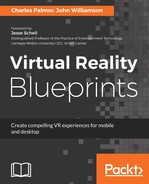Book Description
Join the virtual reality revolution by creating immersive 3D games and applications with Cardboard VR, Gear VR, OculusVR, and HTC Vive
About This Book
- Develop robust, immersive VR experiences that are easy on the eye.
- Code 3D games and applications using Unity 3D game engine.
- Learn the basic principles of virtual reality applications
Who This Book Is For
If you are a game developer and a VR enthusiast now looking to get stuck into the VR app development process by creating VR apps for different platforms, then this is the book for you. Familiarity with the Unity game engine and the C# language is key to getting the most from this book.
What You Will Learn
- Use Unity assets to create object simulation.
- Implement simple touch controls in your application.
- Apply artificial intelligence to achieve player and character interaction.
- Add scripts for movement, tracking, grasping, and spawning.
- Create animated walkthroughs, use 360-degree media, and build engaging VR experiences.
- Deploy your games on multiple VR platforms.
In Detail
Are you new to virtual reality? Do you want to create exciting interactive VR applications? There's no need to be daunted by the thought of creating interactive VR applications, it's much easier than you think with this hands-on, project-based guide that will take you through VR development essentials for desktop and mobile-based games and applications. Explore the three top platforms - Cardboard VR, Gear VR, and OculusVR - to design immersive experiences from scratch.
You'll start by understanding the science-fiction roots of virtual reality and then build your first VR experience using Cardboard VR. You'll then delve into user interactions in virtual space for the Google Cardboard then move on to creating a virtual gallery with Gear VR. Then you will learn all about virtual movements, state machines, and spawning while you shoot zombies in the Oculus Rift headset. Next, you'll construct a Carnival Midway, complete with two common games to entertain players.
Along the way, you will explore the best practices for VR development, review game design tips, discuss methods for combating motion sickness and identify alternate uses for VR applications
Style and approach
A project-based guide with every project built across chapters.
